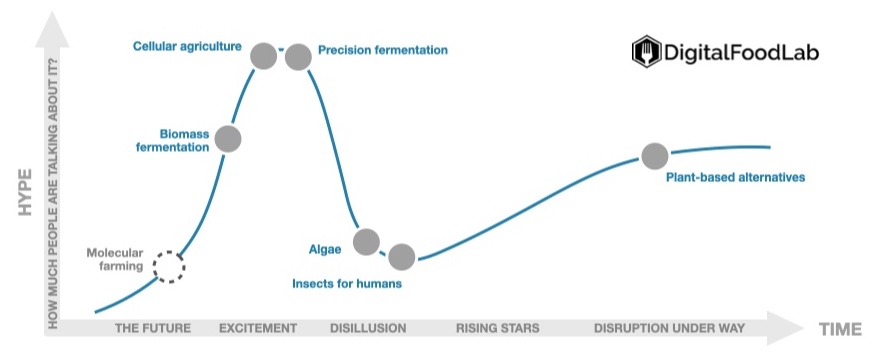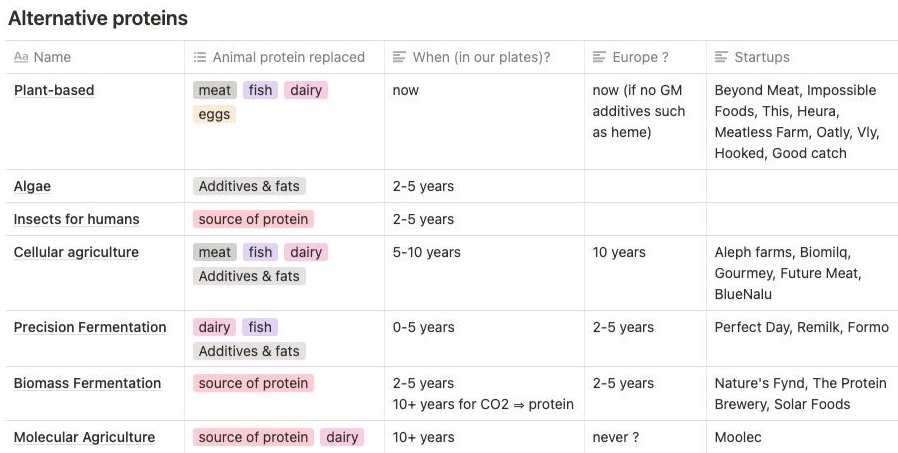Nowadays, it seems that everyone is talking about alternative proteins. That’s great, don’t get me wrong. But, it also seems that there is a lot of confusions between:
- what we mean by that and the various types of alternative proteins
- who is doing what
- when (or if) the products will reach the market
- other non-technical factors that could fasten and threaten the progress of these alternatives, such as regulations (from market authorisations to the ability to “name” the products), acceptability by the consumer, etc.
Hence, today, I would like to share with your our regard on this ecosystem with the most accessible definitions of the various types of technologies, their advancement and our expectations for each.
6 types of alternative proteins

First, what are the various technologies? As shown in the graph above (from left to right, how advanced the technology is in terms and how ready the market is, and from bottom to top, how “hype”, or how much money investors are betting into the area), we have:
- Plant-based alternatives now reach consumers massively with startups such as Beyond Meat and Impossible Foods (and many others). These startups mix various plants to recreate the texture of the meat, dairy product or seafood they are looking to replace. While often branded as tech startups, a quick look at their intellectual property show that they rely much more on trade secrets (recipes, sourcing and machine parameters) than technology.
- Algae & insects, which are both in the phase of disillusion: after years of hope, now, the rise of plant-based and the arrival of new technologies make these two alternatives much less compelling as the primary source of protein to replace animal products. However, startups such as Algama or Triton may have exciting technologies and functional ingredients to help other alternatives succeed.
- Often grouped in one big “lab-grown foods”, precision fermentation and cellular agriculture are both generating a lot of excitement.
- Cellular agriculture is the idea of taking some cells from an animal and letting them multiply in a specific medium to recreate meats, seafood and dairy products. Only one product (sold by Just Foods) is available in Singapore. The road to market is still far away.
- Precision fermentation relies on a much more well-known technology. The basic principle is to genetically modify a yeast which will then produce desired proteins. These can be hence used to replace some functionalities of dairy and eggs. The regulatory path appears to be much simpler. Perfect Day is the most well-known startup in this space and has already some partners selling ice cream using its artificial proteins in the US.
- Biomass fermentation regroups all the startups that use fermentation to create massive amounts of proteins. Their story mostly starts with the identification of a specific yeast or bacteria that has extraordinary capabilities such as:
- Thriving in extremely hostile conditions and hence requiring limited amounts of energy. This is what Nature’s Fynd is working on with products already on the market.
- Absorbing to grow and so creating protein “out of polluted air”. Solar Foods is leading in this space.
- Still, very far from being on our plates, a handful of startups such as Moolec are now working on molecular farming, a new set of technologies that aim at recreating animal proteins out of plants. The idea is to genetically modify plants to have them produce the proteins that we want (such as dairy proteins).

This is obviously a quick summary as we can’t put everything in a newsletter. I hope it will be useful for those who have doubts about the various alternatives to protein. All definitions and timelines are mines, so feel free to challenge them! And obviously, if you are interested in the subjects, want to discover more about it or deep dive into how your company could explore this ecosystem, let us know!







